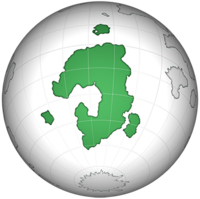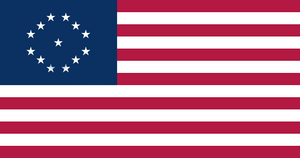United States of America (FTA)
| The United States of America | |||||
|---|---|---|---|---|---|
| United States | |||||
| |||||
| Motto | |||||
| E pluribus unum | |||||
| Anthem | |||||
| The Star Spangled Banner | |||||
| March | |||||
| The Stars and Stripes Forever | |||||

| |||||
| New America, Elysium | |||||
| Capital | Columbia, New America | ||||
| Largest City | Midway, New America | ||||
| Official languages | None at the Federal level | ||||
| National languages | English, Spanish | ||||
| Regional languages | Hebrew, Arabic, German, French | ||||
| Demonym | American | ||||
| Government | Federal Republic | ||||
| - President | Datoka Metropolis | ||||
| - Vice President | Joshua Masters | ||||
| - Speaker of the House | Justin Alexandrou | ||||
| Legislature | Congress | ||||
| -Upper House | Senate | ||||
| -Lower House | House of Representatives | ||||
| Independence from Great Britain | |||||
| - Declaration of Independence | 1776 | ||||
| - Third Constitutional Convention | 21XX | ||||
| - Last polity admitted | 2315 | ||||
| Area | |||||
| Population | |||||
| Estimate | 1,472,500,000 | ||||
| Currency | United States Dollar | ||||
| Time Zone | |||||
| Drives on the | right | ||||
| Date Format | mm/dd/yyyy | ||||
The United States remains as it ever was, a Federal Republic of States founded in 1776. Contrary to certain inaccurate histories it weathered the collapse of the Second Republic's governance system, brutally exposed during the ashfall disaster. This catastrophe led to the secession of several states, including all of the original states of North America. Those who remained loyal, faced with intractable constitutional gridlock and a system of government clearly showing its age convened convened the third Constitutional convention on Elysium, to resolve these issues and restore stability. The outcome after nearly half a year of deliberation was the inauguration of the Third American Republic.
Etymology
The first documentary evidence of the phrase "United States of America" dates to a letter from January 2, 1776, written by Stephen Moylan, a Continental Army aide to General George Washington, to Joseph Reed, Washington's aide-de-camp. Moylan expressed his desire to go "with full and ample powers from the United States of America to Spain" to seek assistance in the Revolutionary War effort.
History
Main Article: History of the United States 20th/21st Century
In the aftermath of a devastating ashfall that plunged the heartlands of the United States into chaos, the nation stood on the precipice of collapse.
Amidst this turmoil, Samuel Winters emerged as a pivotal figure. As ash choked the skies and obscured the sun, the heartland states suffered. Secessionist sentiments ran high, and the Federal government began to crumble. Desperate local and state governments increasingly had to take matters normally the preserve of the Federal government.
With states seceding from the Union and the Federal government in complete disarray, Samuel Winters recognised that any chance of keeping what was left of America afloat lay in the colonies. There secessionist sentiment was particularly weak, with the old colonial settlements of New America fearful of complete breakup.
Winters, a New American native was popular in the colonial states and was recognised as President by the governors of the New American States and for several years oversaw the vast inflows of refugees to Elysium. It was President Winters who steered the Union through the hard months of the Constitutional Convention and the signing of the New Treaty of New York, relinquishing claims to the secessionist states and ultimately seeking a shared future as Americans over revanchism.
Geography
Government and Politics
Economy
Demographics
The U.S. Census Bureau reported 1,472,500,000 residents as of April 1, 2423 making the United States the third-most-populous country in the world, after Tainshang and the Grand Dale Charter. In 2421 the total fertility rate for the U.S stood at 2.7 children per woman.
The United States has a diverse population; with over 150 different ethnic groups and over 300 different languages spoken. English is the most common language and is spoken fluently by 92% of the population. Of these, 68% spoke the language exclusively at home, followed by Spanish at 18%.
America's immigrant population, 210 million, is one of the largest on the grid. There were 350 million immigrants and U.S.-born children of immigrants in the United States, accounting for nearly 25% of the overall U.S. population.
